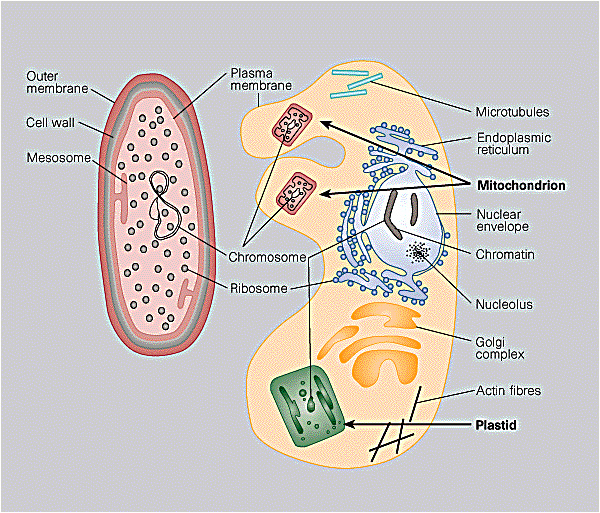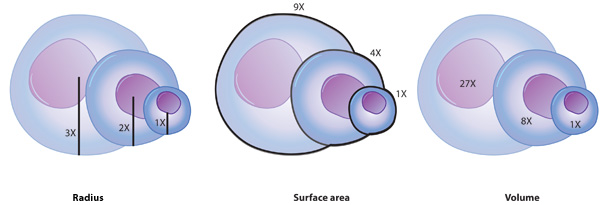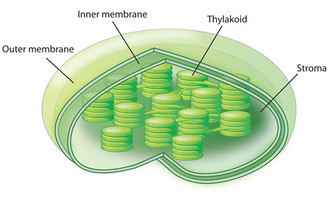What Defines an Organelle?
In addition to the nucleus, eukaryotic cells may contain several other types of organelles, which may include mitochondria, chloroplasts, the endoplasmic reticulum, the Golgi apparatus, and lysosomes. Each of these organelles performs a specific function critical to the cell's survival. Moreover, nearly all eukaryotic organelles are separated from the rest of the cellular space by a membrane, in much the same way that interior walls separate the rooms in a house. The membranes that surround eukaryotic organelles are based on lipid bilayers that are similar (but not identical) to the cell's outer membrane. Together, the total area of a cell's internal membranes far exceeds that of its plasma membrane.
Like the plasma membrane, organelle membranes function to keep the inside "in" and the outside "out." This partitioning permits different kinds of biochemical reactions to take place in different organelles. Although each organelle performs a specific function in the cell, all of the cell's organelles work together in an integrated fashion to meet the overall needs of the cell. For example, biochemical reactions in a cell's mitochondria transfer energy from fatty acids and pyruvate molecules into an energy-rich molecule called adenosine triphosphate (ATP). Subsequently, the rest of the cell's organelles use this ATP as the source of the energy they need to operate.
Because most organelles are surrounded by membranes, they are easy to visualize — with magnification. For instance, researchers can use high resolution electron microscopy to take a snapshot through a thin cross-section or slice of a cell. In this way, they can see the structural detail and key characteristics of different organelles — such as the long, thin compartments of the endoplasmic reticulum or the compacted chromatin within the nucleus. An electron micrograph therefore provides an excellent blueprint of a cell's inner structures. Other less powerful microscopy techniques coupled with organelle-specific stains have helped researchers see organelle structure more clearly, as well as the distribution of various organelles within cells. However, unlike the rooms in a house, a cell's organelles are not static. Rather, these structures are in constant motion, sometimes moving to a particular place within the cell, sometimes merging with other organelles, and sometimes growing larger or smaller. These dynamic changes in cellular structures can be observed with video microscopic techniques, which provide lower-resolution movies of whole organelles as these structures move within cells.
Why Is the Nucleus So Important?
Of all eukaryotic organelles, the nucleus is perhaps the most critical. In fact, the mere presence of a nucleus is considered one of the defining features of a eukaryotic cell. This structure is so important because it is the site at which the cell's DNA is housed and the process of interpreting it begins.
Recall that DNA contains the information required to build cellular proteins. In eukaryotic cells, the membrane that surrounds the nucleus — commonly called the nuclear envelope — partitions this DNA from the cell's protein synthesis machinery, which is located in the cytoplasm. Tiny pores in the nuclear envelope, called nuclear pores, then selectively permit certain macromolecules to enter and leave the nucleus — including the RNA molecules that carry information from a cellular DNA to protein manufacturing centers in the cytoplasm. This separation of the DNA from the protein synthesis machinery provides eukaryotic cells with more intricate regulatory control over the production of proteins and their RNA intermediates.
In contrast, the DNA of prokaryotic cells is distributed loosely around the cytoplasm, along with the protein synthesis machinery. This closeness allows prokaryotic cells to rapidly respond to environmental change by quickly altering the types and amount of proteins they manufacture. Note that eukaryotic cells likely evolved from a symbiotic relationship between two prokaryotic cells, whereby one set of prokaryotic DNA eventually became separated by a nuclear envelope and formed a nucleus. Over time, portions of the DNA from the other prokaryote remaining in the cytoplasmic part of the cell may or may not have been incoporated into the new eukaryotic nucleus (Figure 3).

Figure 3: Origin of a eukaryotic cell.
A prokaryotic host cell incorporates another prokaryotic cell. Each prokaryote has its own set of DNA molecules (a genome). The genome of the incorporated cell remains separate (curved blue line) from the host cell genome (curved purple line). The incorporated cell may continue to replicate as it exists within the host cell. Over time, during errors of replication or perhaps when the incorporated cell lyses and loses its membrane separation from the host, genetic material becomes separated from the incorporated cell and merges with the host cell genome. Eventually, the host genome becomes a mixture of both genomes, and it ultimately becomes enclosed in an endomembrane, a membrane within the cell that creates a separate compartment. This compartment eventually evolves into a nucleus.
© 2013 Nature Education All rights reserved. 
Why Are Mitochondria and Chloroplasts Special?
Besides the nucleus, two other organelles — the mitochondrion and the chloroplast — play an especially important role in eukaryotic cells. These specialized structures are enclosed by double membranes, and they are believed to have originated back when all living things on Earth were single-celled organisms. At that time, some larger eukaryotic cells with flexible membranes "ate" by engulfing molecules and smaller cells — and scientists believe that mitochondria and chloroplasts arose as a result of this process. In particular, researchers think that some of these "eater" eukaryotes engulfed smaller prokaryotes, and a symbiotic relationship subsequently developed. Once kidnapped, the "eaten" prokaryotes continued to generate energy and carry out other necessary cellular functions, and the host eukaryotes came to rely on the contribution of the "eaten" cells. Over many generations, the descendants of the eukaryotes developed mechanisms to further support this system, and concurrently, the descendants of the engulfed prokaryotes lost the ability to survive on their own, evolving into present-day mitochondria and chloroplasts. This proposed origin of mitochondria and chloroplasts is known as the endosymbiotic hypothesis.

Figure 4: The origin of mitochondria and chloroplasts
Mitochondria and chloroplasts likely evolved from engulfed bacteria that once lived as independent organisms. At some point, a eukaryotic cell engulfed an aerobic bacterium, which then formed an endosymbiotic relationship with the host eukaryote, gradually developing into a mitochondrion. Eukaryotic cells containing mitochondria then engulfed photosynthetic bacteria, which evolved to become specialized chloroplast organelles.
© 2010 Nature Education All rights reserved. 
In addition to double membranes, mitochondria and chloroplasts also retain small genomes with some resemblance to those found in modern prokaryotes. This finding provides yet additional evidence that these organelles probably originated as self-sufficient single-celled organisms.
Today, mitochondria are found in fungi, plants, and animals, and they use oxygen to produce energy in the form of ATP molecules, which cells then employ to drive many processes. Scientists believe that mitochondria evolved from aerobic, or oxygen-consuming, prokaryotes. In comparison, chloroplasts are found in plant cells and some algae, and they convert solar energy into energy-storing sugars such as glucose. Chloroplasts also produce oxygen, which makes them necessary for all life as we know it. Scientists think chloroplasts evolved from photosynthetic prokaryotes similar to modern-day cyanobacteria (Figure 4). Today, we classify prokaryotes and eukaryotes based on differences in their cellular contents (Figure 5).

Figure 5: Typical prokaryotic (left) and eukaryotic (right) cells
In prokaryotes, the DNA (chromosome) is in contact with the cellular cytoplasm and is not in a housed membrane-bound nucleus. In eukaryotes, however, the DNA takes the form of compact chromosomes separated from the rest of the cell by a nuclear membrane (also called a nuclear envelope). Eukaryotic cells also contain a variety of structures and organelles not present in prokaryotic cells. Throughout the course of evolution, organelles such as mitochondria and chloroplasts (a form of plastid) may have arisen from engulfed prokaryotes.
© 1998 Nature Publishing Group Doolittle, W. F. A paradigm gets shifty. Nature 392, 15-16 (1998). All rights reserved. 
How Do Eukaryotic Cells Handle Energy?
Mitochondria — often called the powerhouses of the cell — enable eukaryotes to make more efficient use of food sources than their prokaryotic counterparts. That's because these organelles greatly expand the amount of membrane used for energy-generating electron transport chains. In addition, mitochondria use a process called oxidative metabolism to convert food into energy, and oxidative metabolism yields more energy per food molecule than non-oxygen-using, or anaerobic, methods. Energywise, cells with mitochondria can therefore afford to be bigger than cells without mitochondria.
Within eukaryotic cells, mitochondria function somewhat like batteries, because they convert energy from one form to another: food nutrients to ATP. Accordingly, cells with high metabolic needs can meet their higher energy demands by increasing the number of mitochondria they contain. For example, muscle cells in people who exercise regularly possess more mitochondria than muscle cells in sedentary people.
Prokaryotes, on the other hand, don't have mitochondria for energy production, so they must rely on their immediate environment to obtain usable energy. Prokaryotes generally use electron transport chains in their plasma membranes to provide much of their energy. The actual energy donors and acceptors for these electron transport chains are quite variable, reflecting the diverse range of habitats where prokaryotes live. (In aerobic prokaryotes, electrons are transferred to oxygen, much as in the mitochondria.) The challenges associated with energy generation limit the size of prokaryotes. As these cells grow larger in volume, their energy needs increase proportionally. However, as they increase in size, their surface area — and thus their ability to both take in nutrients and transport electrons — does not increase to the same degree as their volume. As a result, prokaryotic cells tend to be small so that they can effectively manage the balancing act between energy supply and demand (Figure 6).

Figure 6: The relationship between the radius, surface area, and volume of a cell
Note that as the radius of a cell increases from 1x to 3x (left), the surface area increases from 1x to 9x, and the volume increases from 1x to 27x.
© 2010 Nature Education All rights reserved. 
Conclusion
Organelles serve specific functions within eukaryotes, such as energy production, photosynthesis, and membrane construction. Most are membrane-bound structures that are the sites of specific types of biochemical reactions. The nucleus is particularly important among eukaryotic organelles because it is the location of a cell's DNA. Two other critical organelles are mitochondria and chloroplasts, which play important roles in energy conversion and are thought to have their evolutionary origins as simple single-celled organisms.


















